![]()
![]()
![]()
Use LEFT and RIGHT arrow keys to navigate between flashcards;
Use UP and DOWN arrow keys to flip the card;
H to show hint;
A reads text to speech;
109 Cards in this Set
- Front
- Back
|
What is Nutrition?
|
-is a science that studies the interactions between living organisms and food.
Food provides nutrients and energy. |
|
|
Nutrients
|
are chemical substances in foods that provide energy and structure and help regulate body processes.
|
|
|
Dietetics
|
is the science or art of applying the principles of nutrition to the diet
|
|
|
Why is the American diet unhealthy?
|
Too many SoFAS (Solid Fats and Added Sugars), calories, and sodium
Too few vegetables and fruits Lack of knowledge? Limited access to healthy foods? Limited ability to prepare foods, due to lack of skills, lifestyle? Taste preferences developed during childhood |
|
|
Essential Nutrients
|
must be provided in the diet.
|
|
|
Fortified Foods
|
foods have nutrients added
|
|
|
Enriched Grains
|
grains have thiamin, riboflavin, niacin, iron and folic acid added after they were removed during processing
|
|
|
Dietary Supplements
|
contains one or more of the following: vitamins, minerals, plant-derived substances, amino acids, or concentrates or extracts.
|
|
|
Macronutrients
|
-Energy-yielding nutrients include carbohydrates, proteins and fats.
-Energy-yielding nutrients are also called macronutrients. -Macronutrients are needed in the body in large amounts each day. |
|

|
The grams of carbohydrates, fat, and protein determine the number of kcalories in a food
|
|
|
Carbohydrates
|
Carbohydrates include sugars and starches.
Carbohydrates provide 4 kilocalories/gram. Fiber belongs to the category of carbohydrates but provides less energy. |
|
|
Lipids
|
Lipids are commonly called “fats” or “oils.”
Lipids are a concentrated form of energy. Lipids contain 9 kilocalories/gram. |
|
|
Proteins
|
Proteins are required for growth, maintenance and repair of the body.
Proteins can also supply energy. Proteins are made up of different combinations of amino acids. Proteins provide 4 kilocalories/gram. |
|
|
Classes of Nutrients: Micronutrients
|
Micronutrients provide no energy for the body but are necessary for proper functioning of the body.
Micronutrients include vitamins and minerals. Micronutrients are very important for good health but are required in small amounts. Micronutrients can be found in most fresh foods. |
|
|
Water
|
Water is a macronutrient, meaning that it is required in large amounts.
Water does not provide kilocalories. Water makes up approximately 60% of the healthy human body. |
|
|
Functions of Nutrients
|
Providing Energy
Working together, macronutrients and micronutrients help the body to stay healthy. Biochemical reactions in the body help to release the energy contained in carbohydrates, fats and proteins. Energy is used to maintain body functions and fuel physical work. |
|
|
Functions of Nutrients
|
Forming Structures
Most of the weight of the body is due to water, fat and protein. Nutrients help to form and maintain the shape and structure of the body. Proteins form ligaments and tendons that hold bones together and attach muscles to bones. At the cellular level, lipids and proteins make up the membranes that surround cells. |
|
|
Regulating Body Processes
|
All the reactions that occur in the body are called metabolism.
The proper regulation of metabolism is called homeostasis. Each nutrient plays a role in helping to maintain homeostasis. Water helps to regulate temperature. Protein, vitamins and minerals help to speed up or slow down metabolic reactions. |
|
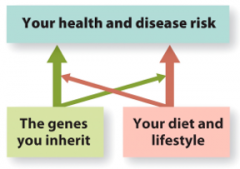
Diet, Genes and Health: Nutrigenomics
|
The study of how diet affects genes and how genetic variation can affect the impact of nutrients on health.
|
|
|
Food Choices: Availability
|
Geography
Transportation and mobility Available income Food storage and preparation equipment |
|
|
Food Choices: Cultural and Personal Background
|
Religious dietary laws
Ethnic menu preferences Social acceptability Personal preference -Vegetarian, vegan -Environmental concerns Psychological and emotional factors Health concerns |
|
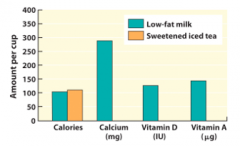
Nutrient Density
|
is a measure of the nutrient a food provides compared to its energy content.
|
|
|
Eat a Variety of Foods
|
No one food provides all necessary nutrients.
Selecting a variety of foods helps the body to obtain all necessary nutrients. There are many interactions between foods. Selecting a variety of foods means you will provide the fuel the body needs, even if some of the food interactions are not positive. |
|
|
Balance Your Choices
|
There is no good food/bad food.
Balancing foods allow all foods to fit in a healthy diet. |
|
|
Everything in Moderation
|
Moderation means all types of foods and beverages are okay, as long as they are taken in moderation.
Moderation means not consuming too much energy, fat, sugar, sodium or alcohol. |
|
|
Understanding Science
|
Nutrition is a science.
Developing an understanding of the processes in nutritional science will help us to understand the relationship between nutrition and health. Understanding nutritional processes will help us to make wise nutrition decisions. |
|
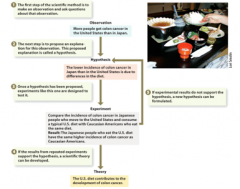
The Scientific Method
|
Advances in nutrition are made using the scientific method.
The scientific method uses an unbiased approach to examine the interaction of food, nutrients and health. The steps in the scientific method are: Observation Hypothesis Theory |
|
|
What Makes a Good Experiment?
|
A well-conducted experiment requires:
Quantifiable Data - Can we measure the information in a scientific manner? Appropriate Experimental Population - Is the population large enough and pertinent to the study? Proper Controls - Can we ensure that the population ate or drank what we said they did? Control groups act as a standard of comparison. Placebos are identical in appearance to the actual treatment but of no therapeutic value. Single-blind study: subjects do not know which treatment they are receiving Double-blind study: neither the subjects nor the investigators know which treatment is being received The peer review system allows for scientific interpretation of experimental results. |
|
|
Types of Nutrition Research Studies
|
Observational studies can include epidemiology, the study of diet, health and disease patterns, and correlation.
Human intervention studies are also known as clinical trials. Laboratory studies are conducted in research facilities such as hospitals or universities. |
|
|
Identifying Reliable Nutrition Information
|
Does the information make sense?
For example, can you really lose forty pounds in one week? What’s the source? Is it selling something? Is it someone’s opinion? Who is a legitimate source of information? Who will benefit when you purchase this product? Is it based on good science? Is the information based on well-designed, accurately-interpreted research studies? Has this product stood the test of time? Many studies duplicated over a period of time show the same results |
|
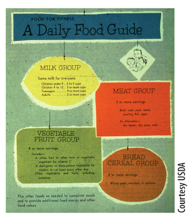
USDA: Nutrition Guidelines Timeline
1956 |
The Basic 4 recommend a minimum number of foods from each of four food groups, milk, meat, vegetables and fruits, and bread and cereal
|
|
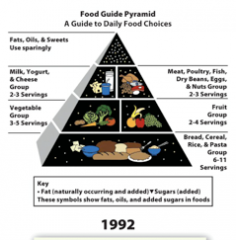
1992
|
The 1992 Food Guide Pyramid organized food into a pyramid shape to emphasize the relative distribution of each group, more should be consumed from the larger food groups at the bottom
|
|
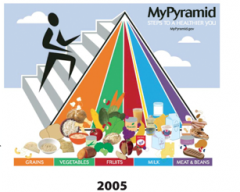
2005
|
MyPyramid: Steps to a Healthier You kept the pyramid concept, but changed the shapes and arrangement of the food groups and added activity to the graphic
|
|

2011
|
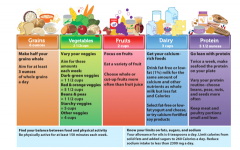
MyPlate, shown here, was introduced in 2011 and is the latest food guide
|
|
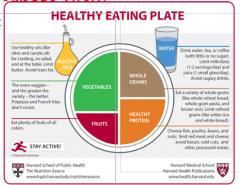
Alternate view of MyPlate
|
no back
|
|
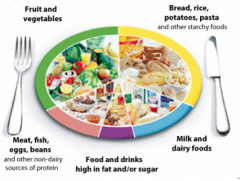
Britain's Eatwell Plate
|
no back
|
|
|
Dietary Reference Intakes
|
Nutrition recommendations need to satisfy a variety of needs.
Different types of dietary guidelines target different populations. The original dietary standards were the RDAs (Recommended Dietary Allowances). The DRIs (Dietary Reference Intakes) are energy and nutrient recommendations that have replaced the RDAs. |
|
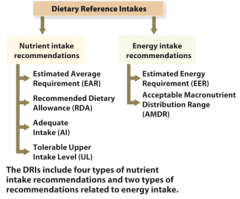
Dietary Reference Intakes
|
DRIs have been developed for six nutrient groups:
1. Calcium, phosphorus, magnesium, vitamin D and fluoride 2. B vitamins and choline 3. Vitamin C, vitamin E, selenium and beta-carotene 4. Energy and macronutrients 5. Electrolytes and water DRIs are designed for planning and assessing diets of healthy people. Amounts recommended by DRIs are meant to promote good health and reduce incidence of chronic disease. The DRIs are not necessarily to be consumed every day but should be consumed on most days, as an average intake. |
|
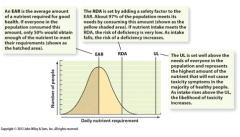
Dietary Reference Intakes: 4 Sets
|
The DRIs for macro- and micronutrients are listed in four different sets of values:
1. Estimated Average Requirement (EAR) is used to evaluate nutrient intakes of populations. 2. Adequate Intakes (AI) recommend specific amounts of nutrients for individuals. 3. Recommended Dietary Allowances (RDAs) also recommend specific amounts of nutrients for individuals. 4. Tolerable Upper Intake Levels (ULs) help with the prevention of nutrient toxicities. |
|
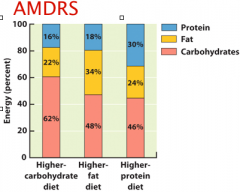
Dietary Reference Intakes: Energy Recommendations
|
The DRIs make two types of energy intake recommendations:
1. Estimated Energy Requirements (EERs) can be used to calculate kcalories needed to ensure a stable weight in a healthy individual. 2. Acceptable Macronutrient Distribution Ranges (AMDRs) are expressed as ranges, or proportions, of nutrients for healthy intake. |
|
|
Dietary Guidelines for Americans
|
The Dietary Guidelines for Americans are a set of diet and lifestyle recommendations designed to promote health and reduce chronic disease risks.
Adequate Nutrients within kcalorie needs Weight Management Physical Activity Food Groups to Encourage Fats Carbohydrates Sodium and Potassium Alcoholic Beverages Food Safety |
|
|
Dietary Guidelines: Foods to Increase
|
Increase fruits and vegetables
Half of grain servings are whole grain Increase low fat dairy Variety of protein including seafood Use oils rather than solid fats These changes will increase potassium, dietary fiber, calcium, and vitamin D |
|
|
Dietary Guidelines: Foods to Reduce
|
Reduce saturated fat, trans fat, cholesterol and sodium
Reduce beverages with sugar |
|
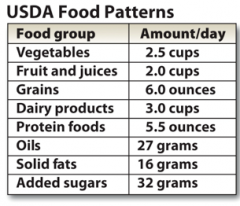
Dietary Guidelines: Building Healthy Eating Patterns
|
no back
|
|
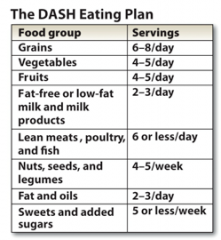
Dietary Guidelines: Building Healthy Eating Patterns
|
no back
|
|

Dietary Guidelines: Building Healthy Eating Patterns
|
no back
|
|
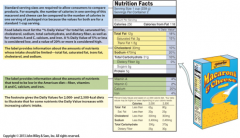
Food Labels: Nutrition Facts Label
|
no back
|
|
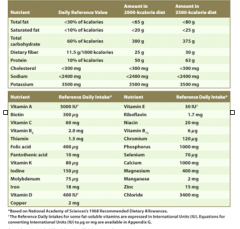
Food Labels: Daily Value
|
Food labels list amounts of certain macro- and micronutrients.
These nutrients are expressed as the Daily Value. Daily Value is the amount of a nutrient in a food shown as a percentage of the recommendation for a person consuming a 2000 kcalorie diet. |
|

Food Labels: List of Ingredients
|
no back
|
|

Food Labels: Nutrient Content Claims
|

|
|
|
Food Labels: Health Claims
|
Authorized Health Claims: Based on Significant Scientific Agreement
Authorized Health Claims: Based on an Authoritative Statement Qualified Health Claims |
|

Assessing Nutritional Health
|
Nutritional assessments can help individuals determine if their intake is healthy.
Dietary Intake can be assessed in several ways: 24-hour recall Food diary or food intake record Food frequency questionnaire Diet history |
|
|
Analyzing Nutrient Intake
|
To get a general nutritional “snapshot,” individual nutrient intake can be compared to recommended intakes.
Nutrient analysis tools can include: MyPlate Food labels Nutrient content tables Computer programs |
|
|
Digestion
|
process of breaking food into components small enough to be absorbed by the body
|
|
|
Absorption
|
process of taking substances into the interior of the body
|
|
|
Gastrointestinal tract
|
hollow tube consisting of the mouth, pharynx, esophagus, stomach, small intestine, large intestine and anus
Food which is inside in the GI tract is considered outside the body |
|
|
Digestive Secretions
|
Digestion inside the GI tract is assisted by digestive secretions.
|
|
|
Mucus
|
viscous material produced by goblet cells; mucus moistens, lubricates and protects the GI tract
|
|
|
Enzymes
|
protein molecules that speed up chemical reactions; enzymes are not changed during reactions
|
|
|
Mouth
|
-The mouth is the entry point for food into the digestive tract.
-Saliva: Moistens food Contains salivary amylase (salivary amylase breaks down starch, lysozyme prevents bacterial growth) Contains lysozyme -You really do need to chew! (physically breaking down food into smaller pieces) |
|
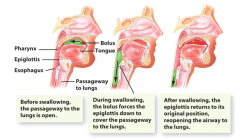
Pharynx and Epiglottis
|
Can’t swallow and breath at the same time
Epiglottis ensures that food can’t go into the lungs Dysfunctional epiglottis can cause aspiration pneumonia |
|
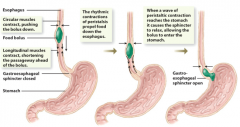
Esophagus
|
Esophogous: Gastroesophageal sphincter prevents stomach acid from coming back into the esophogus and pushes food through
|
|
|
Stomach
|
-Reservoir
-Gastric Juice -Water, mucus, HCl, pepsinogen -Stomach function regulated by both nerves and hormones -Gastric emptying Stomach: stores food and trickles it into the small intestine Stomach is where all of the food is liquified (like a washing machine with mechanical acid Highly acidic environment (cells can handle the acidiity, but not the cells that line the esophogus) Avg person produces 2L/day of gastric juice Hormones manage GI motility high fat meals are where the hormones slow things down and slow gastric emptying Pasta leaves the stomach first leaving you hungrier than after eating ice cream Exercise after eating means blood flow to the muscles and not to gatric emptying |
|
|
Small Intestine
|
Digestion & Absorption
Large surface area: folds, villi Segmentation Enzymes Hormonal Regulation Mostly Absorbption ~20ft long -very large surface area (you want to absorb as much as possible) Segmentation is the process of food moving forward and back and forward and back to maximize exposure of food to the surface area so they can be absorbed. Enzyme list and hormone list in book |
|
|
Gallbladder, Liver and Pancreas
|
Gallbladder stores bile which is produced by the liver.
Pancreas secretes digestive enzymes and bicarbonate ions into the small intestine during digestion. Hormonal Regulation Bicarbonate ion: neutralize the acidity |
|
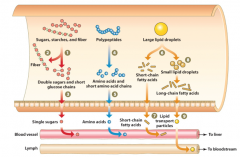
Digestion Nutrient Breakdown
|
no back
|
|
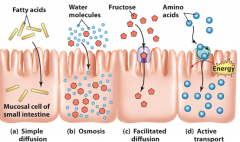
Nutrient Absorption
|
no back
|
|
|
Large Intestine
|
The large intestine can absorb water and some vitamins and minerals.
Intestinal microflora Live on food which has not been absorbed Produce nutrients Produce gas Most absorption in the small intestine! Large intestine: hundreds of types of bacteria which produce nutrients and help the immune system Things slow down in large intestine (24-72hr) |
|
|
Probiotics
|
Live, beneficial bacteria
cfa = colony forming area (should tell on supplement box, that’s how many were alive at the time of manufacture, not how many you are eating) Look at package to see if there were studies done, about how they package them MIxed Research as to whether or not they are helpful Activia Yogurt: Bifidus Regularis (not a real thing) contain 2 different bacterias |
|
|
Prebiotics
|
Food for the beneficial bacteria
Work together with probiotics Food they like: bananas, onions, garlic, and soy beans |
|
|
Celiac Disease
|
-Gluten triggers an immune response which damages the villi of the small intestine
-Different than a wheat allergy -Gluten found in wheat, rye, and barley -Gluten free foods are a $4B food industry -Gluten sensitivity? Villi are important because they inc surface area of small intestine which diminishes absorption of small intestine Some cases can be symptomless, while others are highly sensitive Different then wheat allergy Gluten sensitivity: has some digestive issues and choses to reduce the amount of gluten People that adopt a gluten free diet that don’t have to and feel great, it maybe because they are eating healthier generally, it could be confirmation bias (how did she track her symptoms, recording food logs decrease calorie intake and they end up eating more fruits and vegies) If someone is following a gluten free diet, they might make such a large shift that they stop getting the essential food groups |
|

Common Digestive Problems
|
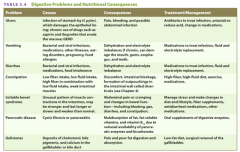
Dry Mouth: caused by medications and some diseases, can move foods around the mouth and gets in the waay of getting in enough food
Dental issues: limit the food you can eat and you can’t do the initial mechanical breakdown Refluxe: when lower esophogeal sphincter doesn’t close and has a large span of what it can cause (prevent GERD by remaining upright after eating and reduce meal size the fuller the stomach, the more likely the valve is to open, avoid high fat food because they relax the sphincter) Diarrhea: cause dehydration and if the food moves too fast through the small intestine, then you are not absorbing all that you could Constipation: caused by fiber and fluid deficiency, lack of activity, causes discomfort and you might not feel like eating very much. treated by increasing fiber slowly and increasing fluid to match |
|

Alternate Feeding Methods
|
If an individual cannot take adequate food or fluid by mouth:
Enteral or tube feeding TPN: total parenteral nutrition Enteral or tube feeding (unable to eat by mouth, can’t swallow or perhaps they have had surget on math): tube into stomach and formula can be put through the tube, tube can also be put into the small intestine TPN: no GI function: put the food directly into the blood stream |
|
|
Transport of Nutrients
|
Cardiovascular System
Liver is the gatekeeper between water-soluble nutrients absorbed in the small intestine and circulation Lymphatic system transports larger, fat soluble materials Nutrients go into the blood Most everything goes through liver into blood stream |
|
|
Metabolism of Nutrients
|
Metabolic pathways are a series of reactions needed to transform food into a final product that can be used by the body.
Catabolic pathways release energy trapped in chemical bonds. Energy from catabolic reactions is converted into ATP. ATP is the energy currency of the cell. Know what the Krebs cycle does, need O2 to make energy, what goes in and what comes out (stick to the high lights) |
|
|
Carbohydrates in the Modern Diet
|
Carbohydrates comprise over half of the American diet.
The AMDR for CHO is 45-65% total calories. Carbohydrates have very negative connotation |
|
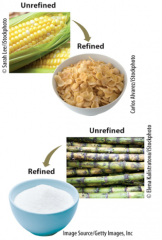
Whole versus Refined Carbohydrates
|
no back
|
|

Whole Grains
|
Whole grain 3 parts:
Bran Endosperm Germ (where the fat of the grain is and vitamin E) |
|
|
Whole Grains versus Refined Grains
|
Refined grains are enriched with thiamin, riboflavin, niacin, and iron
Refined grains are fortified with folate Refined grain: they just take the endosperm and then they have to enrich them fortified with folate (added and it was never there). They fortify to prevent neural tube defect in babied. The fiber and vitamin E is not put back |
|
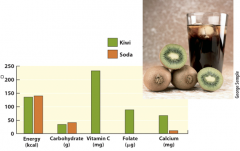
Added Sugars in Our Diet
|
Added sugars make up 16% of the calories consumed in the American diet:
Soda/Juice Cereal fast food restaurants yogurt chocolate milk |
|
|
Simple Carbohydrates
|
The basic unit of a carbohydrate is a single sugar molecule, known as a monosaccharide.
The three most common monosaccharides in the diet are glucose, galactose and fructose. Fructose: fruits, vegetables, honey Galactose: milk (as part of lactose) |
|
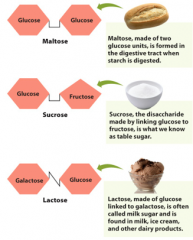
Disaccharides
|
Disaccharides are simple carbohydrates made of two monosaccharides linked together.
Sucrose, or white table sugar, is formed by linking glucose with fructose. Sucrose is the only sweetener in the US that can be labeled “sugar.” |
|
|
Complex Carbohydrates
|
Complex carbohydrates are made up of many monosaccharides linked together in chains.
Oligosaccharides are short chains of less than ten monosaccharides. Polysaccharides are long chains of monosaccharides and include glycogen found in animals and starch and fiber found in plants. “good carbs” oligosaccharides: beans, onions Glycogen: stored in liver and muscle (not a lot of storage space) Carboloading : athletes use to store a little bit more glycogen |
|
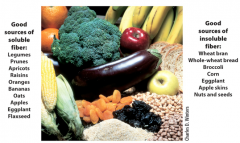
Dietary Fiber
|
Fiber includes certain complex carbohydrates that cannot be digested by human enzymes.
Soluble fiber: Dissolves in water to form a viscous solution Bacteria in large intestine can break it down, producing small quantities of nutrients Insoluble fiber: Does not dissolve in water Cannot be broken down by bacteria -soluble (dissolves in water and forms gel like solution, bacteria in large intestine can eat it and they can produce very small amount of nutrients) vs insoluble (does not dissolve and can’t be broken down) -You need both kinds |
|
|
“Stealth Fiber”: Inulin
|
May be derived from chicory root
Tolerance can vary; may cause gas, bloating, cramps Found in: Fiber One products Starbucks Smoothies? Is this a good way to increase fiber intake? Inulin: Stealth FIber because it is not naturally occurring but is used to bump up the amount of fiber People have varying tolerance to inulin Steers people away from the more natural sources of fiber |
|
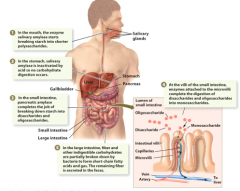
Digestion and Absorption of Carbohydrates
|
Salivary amylase stops in the stomach due to acidity in the stomach
|
|
|
Lactose Intolerance
|
The enzyme lactase is needed to digest lactose, the sugar found in milk.
If lactose is not digested in the small intestine, it passes through to the large intestine. Undigested lactose in the small intestine can cause cramping, abdominal distention and diarrhea. Why? Lactose (disaccharide) can’t be broken down into monosaccharides Osmosis pulls water in to help create this environment of distention and diarrhea More common in certain ethnic groups May be diagnosed with a hydrogen breath test Foods with a high content of lactose may be avoided Lactase may be taken in conjunction with foods containing lactose African American, Asian, Native american H breath test: your body is not digesting lactose, the bacteria is digesting it and produce H Milk Allergy: immune reaction to milk, must stay away from milk completely Lactose Intolerance: Lactase deficiency Treatment: consume lactose free items pill: lactaid supplement, pill provides lactase, pill survives until they need to break down the lactase |
|

Indigestible Carbohydrates Slow Nutrient Absorption
|
Resistant Starch, fiber and oligosaccharides are not digested in the small intestine.
These carbohydrates affect: Transit time The type of intestinal microflora The amount of intestinal gas Nutrient absorption Transit time: decrease time, increase the bulk of the material -Increase type of microflora by providing food, bacteria produces gas -fiber binds to nutrients, but will not decrease absorbancy so much to make you deficient -oatmeal helps to reduce cholestrol (soluble fiber, binds to cholesterol so it doesn’t get absorbs and just gets excreted) -fiber will cause you to feel fuller (bulk) and delay gastric emptying |
|
|
Carbohydrate Function
|
PROVIDE ENERGY
Brain and red blood cells (RBC) can only use glucose By eating carbs you are getting macro and micro nutrients |
|
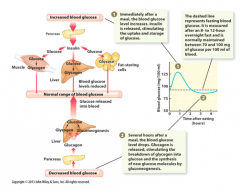
Regulating Blood Glucose
|
In order to provide a steady supply of glucose to the cells, the concentration of glucose in the blood is regulated by the liver and by enzymes secreted from the pancreas.
Glycemic response is how quickly and how high blood glucose rises after carbohydrates are consumed. Amount of CHO Type of CHO Amount of PRO and FAT consumed with CHO |
|
|
Regulating Blood Glucose
|
The glycemic index is a ranking of how a food affects the glycemic response.
Measured against reference food >70 = High; <55 = Low Glycemic load Calculated by multiplying a food’s glycemic index by the amount of available carbohydrate in a serving of the food. People eat a food an are tested Slower = lower index Faster = higher Reference - 100 which is glucose As fruit ripen, the structure of the carb changes, which changes index GI can vary with how the food is prepared |
|
|
Cellular Respiration
|
To generate energy, glucose is metabolized through cellular respiration.
C6 H12 O6 + O2 --->6 CO2 + 6 H2O + ATP Steps 1. Glycolysis yields (2) 3C molecules of pyruvate, ATP, high energy electrons 2. When O2 present, (2) 2C acetyl CoA is formed, also yielding CO2 and high energy electrons 3. Acetyl CoA enters the Citric Acid cycle, yielding more CO2, ATP, and high energy electrons 4. Electron Transport Chain takes high energy electrons to make ATP Cellular Respiration = ATP!!!! |
|
|
When CHO is Limited
|
Gluconeogenesis:
-Occurs in liver and kidney cells -Some amino acids can form 3C molecules of pyruvate or oxaloacetate |
|
|
When CHO is Limited
|
Ketone Formation:
-Oxaloacetete (derived from CHO) is conserved, so acetyl CoA derived from fatty acids will not enter Citric Acid Cycle -Instead, liver converts acetyl CoA to ketones -Ketones can be used as energy by some tissues -Severe ketosis increases blood’s acidity, and can cause death |
|
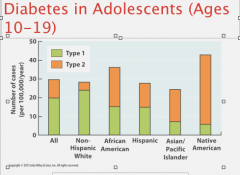
Abnormal Blood Glucose: Diabetes
|
-Diabetes mellitus is the leading cause of blindness in the United States and accounts for 44% of all new cases of kidney failure.
-Gestational diabetes occurs in women during pregnancy. There may be an increased risk of developing type 2 diabetes later in life. -Diabetes mellitus can be classified as: -Type 1 Diabetes: Insulin is no longer made in the body. -Type 2 Diabetes: Insulin is present, but the cells do not respond. Gestational: pregnant woman can lose glucose control, woman are routinely tested when pregnant, that can resolve once they deliver, but they remain at a hgher risk for type 2 diabetes, puts baby and mom at risk Type 2: Pancreas may not produce enough insulin or the cells are not as receptive to the insulin -slower progression of disease Prediabetes (associated to type 2): some indications that the blood glucose level isn’t stabilized as well as it should be Risk factors -genetics -family history -obesity -lifestyle -hormonal changes cause cells to not be as receptive to insulin -diagnosis is close to 20 weeks into pregnancy |
|
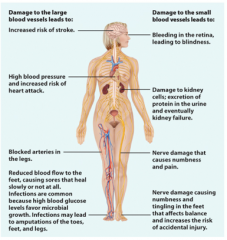
Diabetes Symptoms and Complications
|
Immediate Symptoms: excessive thirst, frequent urination, blurred vision and weight loss.
Long Term Complications: damage to the heart, blood vessels, kidneys, eyes and nervous system. Infections are more common in patients with diabetes, and amputations may be necessary. |
|
|
Diabetes Treatment
|
The goal of diabetes treatment is to keep blood glucose levels within normal ranges.
Diet Exercise Oral Medication Insulin Low carb diet with enough insulin to store glucose Diet*-eat consistently A1C: avg blood glucose over the last 90 days (blood test) Exercise: increases how our muscle cells respond to insulin Oral Medication: aim to increase insulin, to decrease liver production of glucose, and several other targets Insulin: required for type 1, type 2 and gestational may or may not rquire insulin Insulin: long acting (~day), slow acting (take right before meal), options vary for different people, type 1 take both, type 2 might just start with the long term and then add slow acting as needed Type 1 diabetes: glucose remains in blood, cells don’t have have glucose, body makes ketones for energy and indicates a high blood glucose level |
|
|
Hypoglycemia
|
Symptoms: Sweating, Rapid HR, Confusion, Weakness
Treatment: CHO Prevention Balance between insulin and CHO Can happen to anyone (with or without diabetes) Good food: -juice or soda (fast acting) get to the small intestine quickly to be absorbed (pure carbs, no fat to slow down digestion) -it doesn’t take that much (15g of carbohydrate) -glucose tablets, glucose gels -check blood sugar 15 min after Common cold or infection can raise blood sugar -different eating, sleeping, exercising can mess with it -stress can upset balance |
|
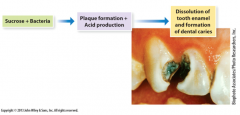
Carbohydrates and Dental Caries
|
Carbs are a source of cavities
Saliva contains lysozymes that help digest carbs Anything that remains on the teeth will cause cavities |
|
|
Low-Carbohydrate Weight Loss Diets
|
-The rationale for low-carbohydrate diets is that foods high in carbohydrates stimulate the release of insulin.
Insulin promotes energy storage, mostly from fat. The more insulin you release, the more fat you store. -Additional protein promotes satiety Diets usually target foods high in carbs with low nutrient density Diets promote more protein, which help people feel more satisfied Diabetes diet: goal is to be consistent with amount of carbs Low carb can range from 30-150g depending on the diet When you remove something from your diet, you have to think about what you will replace it with. |
|
|
Carbohydrates and Heart Disease
|
Diets high in whole grains have been found to reduce the risk of heart disease.
Water-soluble fiber binds dietary cholesterol and reduces absorption. |
|

Fiber and Bowel Disorders
|
Diets high in fiber and indigestible carbohydrates, can relieve or prevent certain bowel disorders:
Hemorrhoids Diverticulosis Diverticulitis Constipation Diverticulosis: pockets in large intestines Diverticulitis: when pockets become inflamed (more of a problem) Increase water intake to match fiber intake |
|
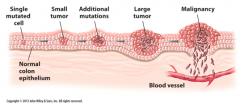
Colon Cancer and Fiber Intake
|
Epidemiological studies have shown that the incidence of colon cancer is lower in populations that consume diets high in fiber, data from intervention studies does not support those studies.
Colon Cancer: Observational research: high fiber lowers risk of colon cancer Clinical research do not reveal the same results |
|
|
CHO Intake Recommendations***
|
DRI: RDA 130g/day
DRI: AMDR 45%-65% total energy DRI: AI for fiber 38g/day adult men; 25g/day adult women 2010 Dietary Guidelines: “reduce added sugars” WHO: <10% total energy from added sugars 130g represents what your brain has to have for daily operations (not necessarily practical when talking about a complete diet) WHO = Worlds Health Organization |
|
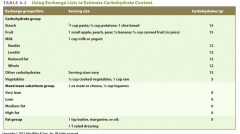
Tools for Assessing Carbohydrate Intake
|

1 exchange or choice = 15g carbs
|
|
|
Sugar Intake
|
Sugar on label include natural and added sugars, which makes it difficult to limit sugar intake
|
|
|
Choosing Carbohydrates Wisely
|
Choose whole grains
Limit added sugars Increase fruits and vegetables Monitor portions sizes |
|
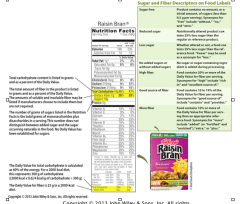
Carbohydrates in Nutrition Labels
|
no back
|
|
|
Alternative Sweeteners
|
Nonnutritive – no kcal
FDA has defined ADI (Acceptable Daily Intakes) based on body weight Useful for weight management? Helpful with weight loss if you directly replace sugar with nonnutritive Research shows that alternative sweeteners may make you crave more sweets |

